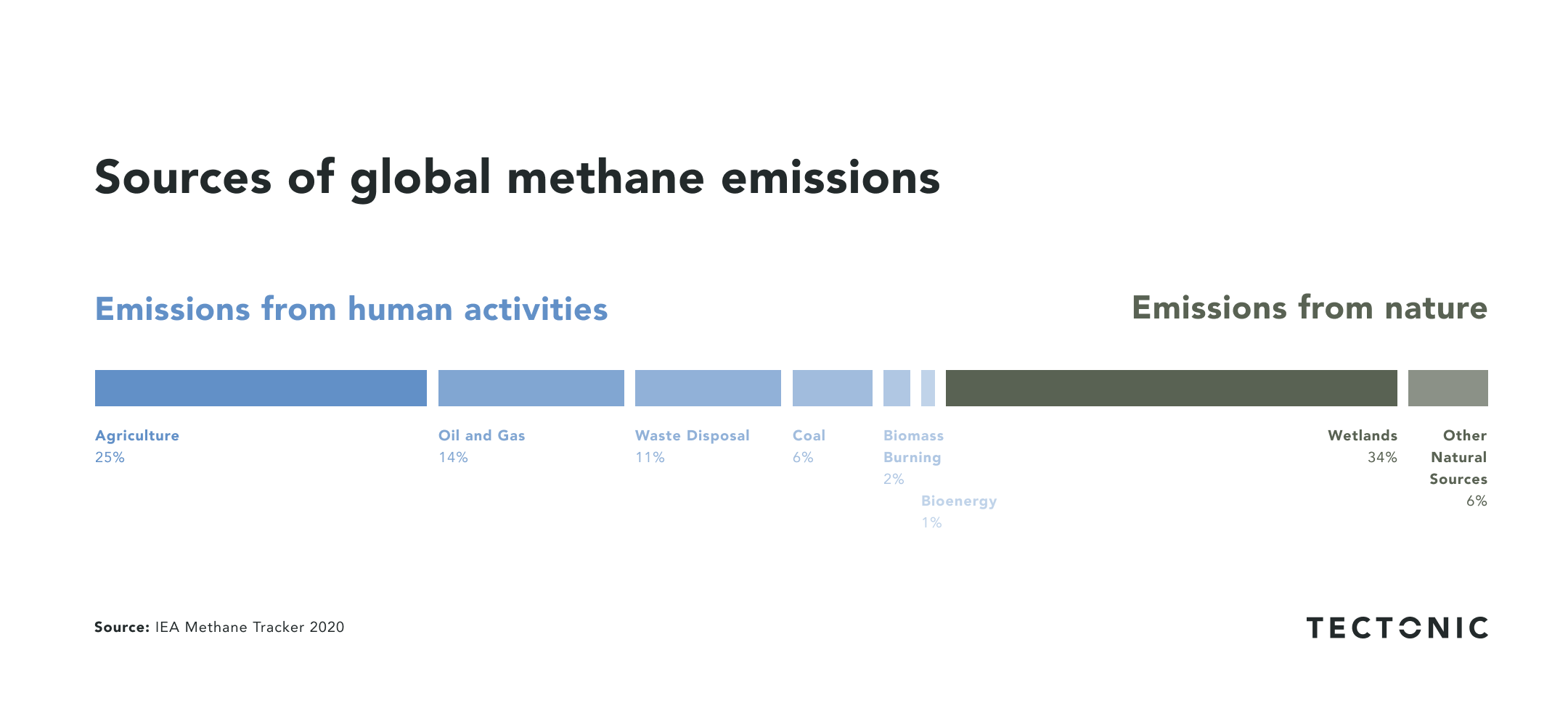Methane is the second most abundant anthropogenic greenhouse gas (GHG) after carbon dioxide, contributing about 16 percent of global emissions. Over the last two centuries, methane concentrations in the atmosphere have more than doubled.
The impact of greenhouse gasses on the climate depends on two main factors: their atmospheric lifespan and their energy absorption capacity. Methane remains in the atmosphere for a relatively short duration, breaking down in about 7 to 12 years, unlike carbon dioxide, which can persist for centuries. However, methane traps heat much more effectively than carbon dioxide, with a global warming potential roughly 84 times greater over a 20-year timescale, making it a major driver of climate change.
What is the source of methane emissions?
Methane is produced through the breakdown and decomposition of organic material, which can occur naturally or as a result of human activities. Natural processes account for part of methane emissions, with wetlands serving as the biggest natural source. However, it is estimated that 60% of today’s methane emissions are directly sourced from human activities.
Agriculture is the largest source at one-quarter of emissions. Animals like cattle, pigs, sheep, and goats generate methane as a natural byproduct of their digestive processes. Additionally, methane is released when animal manure is stored or managed in lagoons or holding tanks.

The energy sector is the second largest emitter. This includes emissions from coal, oil, natural gas, and biofuels, with leaks occurring throughout extraction and distribution. Landfills and wastewater treatment facilities are also notable emitters as organic waste decomposes without oxygen, releasing methane into the air.
Nonetheless, it is estimated that the oil and gas industry has been severely underreporting and disguising methane emissions. Many rely on outdated equipment and voluntary self-reporting, and recent satellite monitoring indicates global methane emissions from the energy sector are 70% higher than reported.
What are the solutions for tracking and mitigating methane emissions?
One of the most promising areas for mitigating methane emissions in the oil and gas sector is leak detection and repair (LDAR) programs. By incorporating technologies such as infrared cameras and optical gas imaging (OGI), satellite sensors, and real-time detection systems, pinpointing and addressing methane leaks is becoming faster and more effective, reducing emissions and minimizing wasted resources. Satellites from Carbon Mapper and MethaneSAT can detect, measure, and track super-emitters from space.
In agriculture, dietary manipulation in the form of feed additives demonstrates the potential to curb methane production in livestock. Startups such as Blue Climate Collective member Symbrosia and Blue Ocean Barns are producing seaweed-based feed additives that minimize the amount of methane emissions released from cows by 30%-80%. Additionally, biogas capture systems on farms and waste facilities harness methane emissions to produce renewable energy, effectively turning a potent greenhouse gas into a sustainable energy source.
Where do we stand, and what can we expect?
The fastest way to slow global warming is to minimize methane emissions.
Global efforts to reduce methane emissions are gaining momentum through initiatives like the Global Methane Pledge, aimed at reducing methane emissions 30% below 2020 levels by 2030, with 159 countries committed to date. Furthermore, initiatives like the Global Methane Alliance are working to align public and private sector efforts to unlock further reductions, potentially achieving between 20% - 50% of the emissions required to limit climate warming to 2 degrees.
We are also witnessing significant regulatory advancements. In November 2024, the U.S. announced a methane fee polluting companies would have to pay if they emit methane above certain levels, though political uncertainty threatens its implementation. In early 2024, the EU adopted its first binding legislation to address methane emissions, mandating stricter regulations for methane emissions in the energy sector. Canada has also set an ambitious target to cut methane emissions by 75% below 2012 levels by 2030.
Despite this progress, methane emissions have continued to rise rapidly in recent years, highlighting the need for more effective monitoring and enforcement of emission reduction strategies. Transforming pledges into meaningful action requires international collaboration, investment, and leadership to meet climate goals and ensure methane remains a priority in the fight against climate change.


